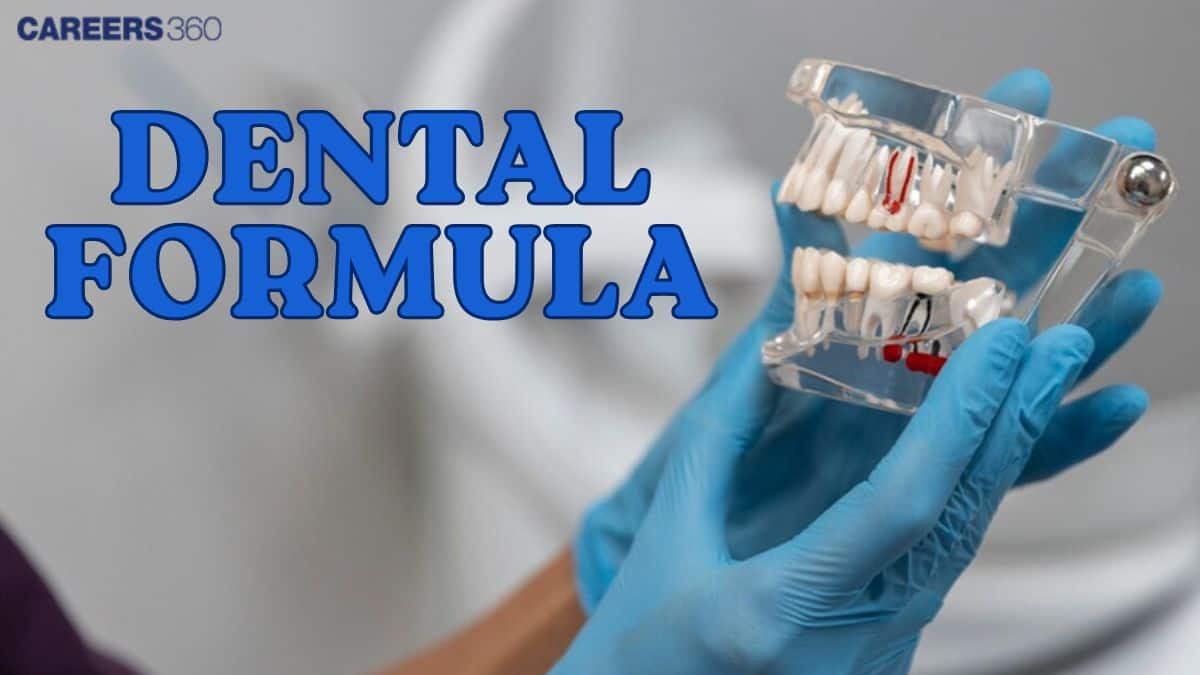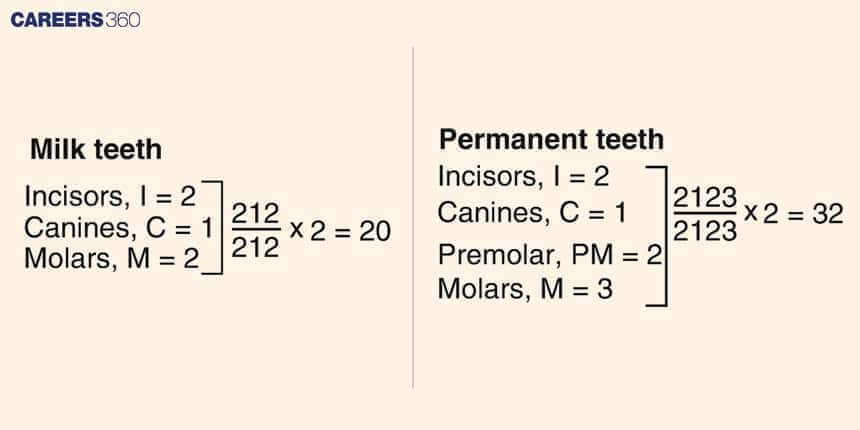Dental Formula- Dentition, Differences, Types, FAQs
The dental formula is a shorthand way to represent the number and types of teeth in one half of the mouth. It reveals dentition patterns, dietary adaptations, and evolutionary traits in humans and animals. This guide explains dental formulas for humans, cows, dogs, and more, with NEET MCQs and diagrams.
This Story also Contains
- Introduction – What is a Dental Formula?
- Human Dental Formula – Primary and Permanent Teeth
- Anatomy and Development of Teeth
- Dental Health and Hygiene
- Dental Formula NEET MCQs
- FAQs on Dental Formula
- Recommended Video for Dental Formula

The dental formula is important for understanding dentition patterns across different species. It explains how incisors, canines, premolars, and molars appear in one half of the mouth. Dental formula relates dietary habits, digestion and absorption, and evolutionary adaptation. For example, the dental formula in advanced mammals is determined by their requirements of feeding, for example, humans have a dental formula of 2:1:2:3 while the dental formula of cows reflects their herbivorous diet. Also, the dental formula in dogs represents a carnivorous diet.
Introduction – What is a Dental Formula?
The dental formula is the expression of the number and types of teeth. It provides a simplified description of dental arrangement to fully understand the function and distribution of the different kinds of teeth. It is helpful in understanding specific dietary adaptations and habitats that have shaped evolution among different species.
The dental formula is the number of each type of tooth represented in one half of the mouth. Four types of teeth are incisors, canines, premolars, and molars. Each type of tooth has a specific function, such as cutting, tearing, and grinding food.
Some of the common examples of dentition are discussed below:
Dental formula of humans: Adults have 2 incisors, 1 canine, 2 premolars, and 3 molars in each quadrant, written as 2:1:2:3.
Deciduous teeth formula: For children, it is 2:1:2 (2 incisors, 1 canine, and 2 molars).
Dental formula of cows: For cows, it is 0:0:3:3 in the upper jaw and 3:1:3:3 in the lower jaw.
Dental formula for dogs: It is 3:1:4:2 in the upper jaw and 3:1:4:3 in the lower jaw.
Human Dental Formula – Primary and Permanent Teeth

Deciduous Teeth
Development of milk teeth includes incisors, canines, and molars. They begin to erupt at six months and finish all their eruptions by three years. The milk teeth are temporary and later are replaced by permanent teeth.
Permanent Teeth
One set of permanent teeth of an adult consists of incisors, canines, premolars, and molars. Permanent teeth start replacing primary teeth at the age of six years, and this process goes on till early adulthood. Permanent teeth are designed to last for a lifetime if treated properly.
Anatomy and Development of Teeth
Each part of the tooth includes :
Enamel: The hard external layer that protects the tooth.
Dentin: The layer supporting the enamel and lying just beneath it.
Pulp: The innermost region containing nerves and blood vessels.
Cementum: The layer that binds the tooth to the jawbone.
Development of the teeth proceeds in a sequence from the crown formation to root development.
The dental formulas of animals are typical and related to the diet and general life habits of animals. Example:
Carnivores: More canines for catching and shredding prey are frequent, and fewer molars for grinding purposes.
Herbivores: More or greater numbers of molars are found for grinding plants, though fewer canines.
Omnivores: A mix of different kinds of teeth is found to make provisions for the different sorts of food.
Dental Health and Hygiene
Good dental health should be practiced by every individual to protect them from common disorders such as caries, periodontal diseases, or loss of teeth. Maintaining good dental hygiene can be ensured by implementing the following practices :
Brushing teeth at least twice a day.
Flossing daily
Regular dental check-ups
Limiting sugary foods and beverages
Dental Formula NEET MCQs
Q1. Dental Formula for human beings is
3223/3223
2123/2123
1232/1232
2233/2233
Correct answer: 2) 2123/2123
Explanation:
The adult human dental formula is 2123/2123.
The number of teeth in each half of the upper and lower jaw is represented by the dental formula. According to the dental formula 2123/2123, there are two incisors, one canine, two premolars, and three molars on each half of the jaw.
Humans have four distinct tooth types: canines (C), incisors (I), premolars (PM), and molars (M). A human adult has thirty-two permanent teeth.
Hence, the correct answer is option 2) 2123/2123.
Q2. Which of the following options represent human dentition?
Diphyodont, thecodont and heterodont
Diphyodont, acrodont and homodont
Acrodont and homodont
Acrodont, thecodont and homodont
Correct answer: 1) Diphyodont, thecodont and heterodont
Explanation:
Human dentition is described as:
Diphyodont: Those animals in which two successive sets of teeth, initially the "deciduous" set and consecutively the "permanent" set occur. 20 deciduous teeth, or baby teeth, first begin to appear at about 6 months of age. Between approximately ages 6 and 12, these teeth are replaced by 32 permanent teeth.
Thecodont: The base of the tooth is completely enclosed in a deep socket of bone.
Heterodont: Presence of different types of teeth.
Hence, the correct answer is option 1) Diphyodont, thecodont and heterodont
Q3. The part of teeth projecting above the gingiva is called
Root
Crown
Socket
Dentine
Correct answer: 2) Crown
Explanation:
Teeth are differentiated into three regions namely crown, neck and root. The part of the tooth projecting above the gum line or gingiva is called the crown.
Hence, the correct answer is option 2) Crown
Also Read:
FAQs on Dental Formula
What is the dental formula for humans?
The dental formula of adult humans is 2.1.2.3/2.1.2.3. This shows that each half of the upper and lower jaws has 2 incisors, 1 canine, 2 premolars, and 3 molars. In total, an adult has 32 permanent teeth.
How do you write a dental formula?
A dental formula represents the number and arrangement of teeth in one half of the upper and lower jaws, written as a fraction: (Upper jaw teeth)/(Lower jaw teeth)
The numbers indicate types of teeth in the order - Incisors (I), Canines (C), Premolars (PM), and Molars (M).
What is the difference between deciduous and permanent dentition?
Deciduous dentition: They are also called milk teeth and are 20 in number. They appear between 6 months and 2 years of age, and are later replaced.
Example: Each half of the upper and lower jaws has 2 incisors, 1 canine, and 2 molars. There are no premolars in deciduous dentition.
Permanent dentition: They are 32 teeth. They replace milk teeth between ages 6–12 years, with third molars (wisdom teeth) that appear later in adult humans.
Example: Each half of the upper and lower jaws has 2 incisors, 1 canine, 2 premolars, and 3 molars
What are the different parts of a tooth?
A tooth has three main parts:
Crown: Visible part above the gum, covered with enamel.
Neck: Junction between crown and root.
Root: Embedded in the jawbone, anchored by cementum and periodontal ligament. Internally, the tooth contains dentine and a central pulp cavity with blood vessels and nerves.
Recommended Video for Dental Formula
Frequently Asked Questions (FAQs)
Disorderly, it tells the dietary habits and evolutionary adaptation of different species in that teeth are specialized to perform certain functions.
Daily brushing, frequent flossing, frequent dental checkups, reduced intake of sugar-rich food.